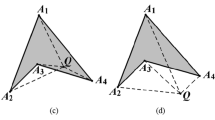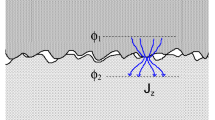Abstract
The general method for calculating the current density in two parallel conductors of arbitrary cross section is used to calculate the current density in two solid conductors of circular cross section that does not change along the conductors. The conductors are supplied from a source of sinusoidal voltage in steady state. Based on the calculated current density, the impedance of a segment of two conductors is examined. The calculated exact inductance values are compared with the values obtained via calculation using formulae published in the literature.





Similar content being viewed by others
References
Coufal O (2014) Current density in two solid parallel conductors and their impedance. Electr Eng 96:287–297. doi:10.1007/s00202-014-0296-z
Coufal O (2007) Current density in a pair of solid coaxial conductors. Electromagnetics 27:299–320
Micu DD, Czumbil L, Christoforidis GC, Papadopulos T (2012) Semi-infinite integral implementation in the development steps of Interfstud electromagnetic interference software. In: 47th International universities’ power egineering conference, London. http://ieeexplore.ieee.org/xpl/articleDetails.jsp?tp=&arnumber=6398640. 4–7 Sept 2012
Deri A, Tevan G, Semlyen A, Castanheira A (1981) The complex ground return plane A simplified model for homogeneous and multi-layer earth return. IEEE Trans Power Appar Syst PAS 100:3686–3693
Budak BM, Fomin SV (1967) Kratnye integraly i ryady. Nauka Publishing House, Moscow
Ralston A, Rabinowitz P (2001) A first course in numerical analysis, 2nd edn. Dover Publications Inc., Mineola, New York
IEC 60050-131:2002/A1:2008 international electrotechnical vocabulary–part 131: circuit theory
Coufal O (2013) On resistance and inductance of solid conductors. J Eng 2013(526072):1–14. doi:10.1155/2013/526072
Lide DR (2007) CRC handbook of chemistry and physics, 88th edn. CRC Press, Boca Raton
Coufal O Current density in a long solitary tubular conductor. J Phys A Math Theor 41(145401): 1–14. doi:10.1088/1751-8113/41/14/145401
Bajcsy J et al (1977) Encyclopaedia of electrical engineering: theoretical electrical engineering, in Slovak, vol 1. Alfa, Bratislava
Haňka L (1975) Electromagnetic theory, in Czech. SNTL, Prague
Maxwell JC (1954) A treatise on electricity and magnetism: unabridged, vol II, 3rd edn. Dover Publications Inc., New York
Jackson JD (1998) Classical electrodynamics, 3rd edn. Wiley, New York
Mayer D (2012) Applied electromagnetism, in Czech. KOPP, České Budějovice
Hlávka J (1968) Electrical engineering I, physical foundations: part 1, in Czech. SNTL, Prague
Matick RE (1995) Transmission lines for digital and communication networks. IEEE Press, New York
Feynman RP, Leighton RB, Sands M (2010) The Feynman lectures on physics. The new millennium edition, vol 2. Basic Books, New York
Coufal O (2012) On inductance and resistance of solitary long solid conductor. Acta Tech 57(1):75–89
Brandão Faria JA (2011) Skin effect in inhomegeneous Euler–Cauchy tubular conductors. Prog Electromagn Res M 18:89–101
Raven MS (2013) Maxwell’s vector potential method, transient currents and the skin effect. Acta Tech 58(3):337–350
Raven MS (2014) Skin effect in the time domain via vector potentials. Acta Tech 59(1):49–62
Acknowledgments
The paper was prepared at the Centre for Research and Utilization of Renewable Energy (CVVOZE). The author gratefully acknowledges financial support from National Feasibility Programme I of the Ministry of Education, Youth and Sport of the Czech Republic under Project No. LO1210.
Author information
Authors and Affiliations
Corresponding author
Rights and permissions
About this article
Cite this article
Coufal, O. Current density in two parallel cylindrical conductors and their inductance. Electr Eng 99, 519–523 (2017). https://doi.org/10.1007/s00202-016-0378-1
Received:
Accepted:
Published:
Issue Date:
DOI: https://doi.org/10.1007/s00202-016-0378-1




